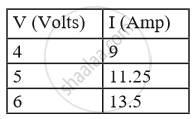Advertisements
Advertisements
प्रश्न
Name the law which relates the current in a conductor to the potential difference across its ends.
उत्तर
Ohm's law gives the relationship between the current in a conductor and the potential difference across its ends. According to this law, at constant temperature, the current flowing through a conductor is directly proportional to the potential difference across its ends.
APPEARS IN
संबंधित प्रश्न
What is meant by saying that the potential difference between two points is 1 V?
Name a device which helps to maintain potential difference across a conductor (say, a bulb).
If the potential difference between the end of a wire of fixed resistance is doubled, by how much does the electric power increase?
If the potential difference between the ends of a fixed resistor is halved, the electric power will become:
The following table shows current in Amperes and potential difference in Volts.
What will be the nature of the graph between the current and potential difference? (Do not draw a graph.)

Write an expression for the electrical power spent in flow of current through a conductor in terms of resistance and potential difference.
From the following observations taken while determining the resistance of a conductor, draw the current-voltage graph and calculate the resistance of conductor. Is the conductor ohmic?
| Ammeter reading I (in ampere) | Voltmeter reading V (in volt) |
| 0.2 | 0.4 |
| 0.3 | 0.6 |
| 0.5 | 1.0 |
| 0.8 | 1.6 |
| 1.5 | 3.0 |
A cylindrical conductor of length l and uniform area of cross section A has resistance R. Another conductor of length 2l and resistance R of the same material has area of cross section
An electric charge always flows from a point at a ______ to a point at a ______.
Define Electric potential.
